|
When It Comes to
Coca-Cola Collectibles―
Buyer Beware
by Bob Brooke
Coca-Cola has been an
icon of American culture since the 19th century. And since its founding,
Coca-Cola has produced a fountain of antiques and collectibles.
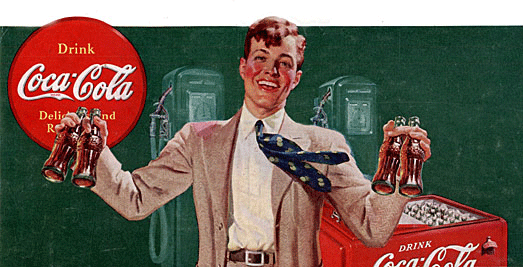
History of the Coca-Cola
Brand
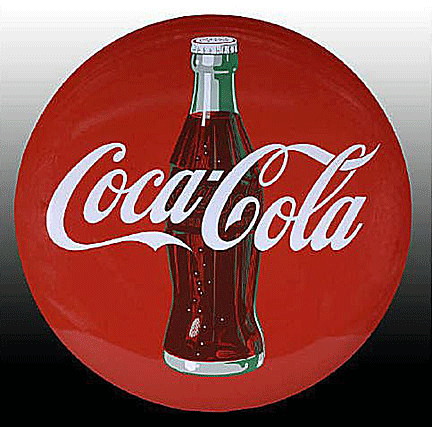 John
Pemberton, a pharmacist, created Coke syrup in 1886. He convinced a
nearby soda fountain in Atlanta to add carbonated water and give it a
try. At first the drink was only a modest success, Pemberton and his
partner, Frank Robertson, came up with the name Coca-Cola, scripted in a
flowing hand by Robertson. That, plus a series of hand-painted banners
encouraged passers-by to "Drink Coca-Cola," was the beginning of a
successful marketing campaign that lives on to this day. John
Pemberton, a pharmacist, created Coke syrup in 1886. He convinced a
nearby soda fountain in Atlanta to add carbonated water and give it a
try. At first the drink was only a modest success, Pemberton and his
partner, Frank Robertson, came up with the name Coca-Cola, scripted in a
flowing hand by Robertson. That, plus a series of hand-painted banners
encouraged passers-by to "Drink Coca-Cola," was the beginning of a
successful marketing campaign that lives on to this day.
Coca-Cola has used its particular shade of red in its merchandising for
more than a century, and its distinctive trademark has remained
virtually unchanged from the original.
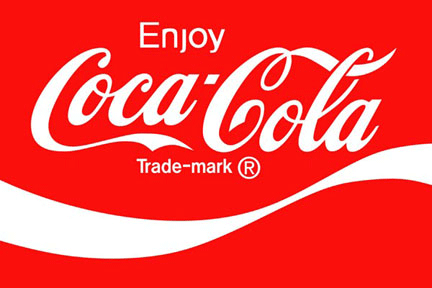
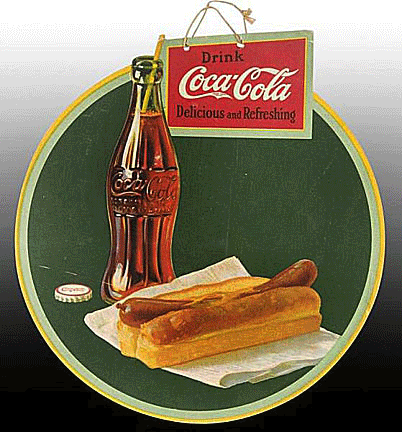 Even
though Pemberton and Robertson founded the company in the late 1890s,
collecting Coca-Cola advertising items---beautiful models printed on
trays, calendars, signs, and even tiny pocket mirrors—didn’t begin to
get popular until the early 20th century. Coca-Cola print advertising
onto just about anything and gave these items out at state fairs and
schools in towns all across the country. Even
though Pemberton and Robertson founded the company in the late 1890s,
collecting Coca-Cola advertising items---beautiful models printed on
trays, calendars, signs, and even tiny pocket mirrors—didn’t begin to
get popular until the early 20th century. Coca-Cola print advertising
onto just about anything and gave these items out at state fairs and
schools in towns all across the country.
Coke’s advertising department placed many of the large, gorgeous
cardboards and metal advertisements with store owners and gas stations
as temporary promotional displays intended for seasonal use. Many ended
in the trash just like those of today. People used signs to patch holes
in roofs, line attic walls, or for target practice.
They cut down calendars to use as photo backings. Just like today, these
were disposable but also useful for other purposes. On rare occasions, a
shopkeeper might even save displays.
Collecting Coca-Cola
Advertising
 Coca-Cola
splashed its trademark logo onto just about everything, including its
bottles, cans, crates, and vending machines. So the variety of items
available ranges widely from little key chains to large sign boards.
Generally, collectors like items produced from the late 1800s to the
1960s and avoid newer items. Coca-Cola
splashed its trademark logo onto just about everything, including its
bottles, cans, crates, and vending machines. So the variety of items
available ranges widely from little key chains to large sign boards.
Generally, collectors like items produced from the late 1800s to the
1960s and avoid newer items.
The general public didn’t take much notice to collecting Coca-Cola until
1971 when a collector/dealer from Texas named Jim Cope pioneered a small
softcover yellow book called “Soda Water Advertising.”
Soon afterward in the same year, a man named Shelly Goldstein started
publishing yellow softcover Coca-Cola price guides with the items in
full color. The following year in 1972, a hard-cover book appeared
written by Cecil Munsey called “The Illustrated Guide to the
Collectibles of Coca-Cola.” In 1974, the first edition of Allan
Petretti’s “Coca-Cola Collectibles Price Guide” came out. It eventually
went through 12 editions, with the last one appearing in 2008. Petretti
added more features and items over the years. His last 645-page guide is
still the quintessential reference book for Coca-Cola collectors today.
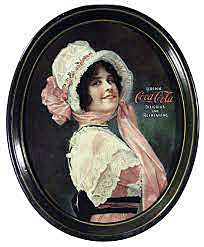 Of
particular interest were items from the first decade of the 20th
century, with beautiful models printed on trays, calendars, signs, and
even tiny pocket mirrors. The company gave out these items liberally
from state fairs to schools in towns all across the United States and
around the world. Of
particular interest were items from the first decade of the 20th
century, with beautiful models printed on trays, calendars, signs, and
even tiny pocket mirrors. The company gave out these items liberally
from state fairs to schools in towns all across the United States and
around the world.
And that’s another reason collecting Coca-Cola advertising is so
popular—it literally has become a global phenomenon.
The location of the trademark notification has also varied throughout
the years. Early on, the trademark appeared inside the long trailing C
in “Coca.” Starting in the 1940s, The company moved it to a position
under the entire word “Coca-Cola.” That happened because the Coca-Cola
Company lost a court case. The result was the loss of the trademark
control over of “Cola” since the trademark notification was only under
“Coca,” not under both parts of the logo.
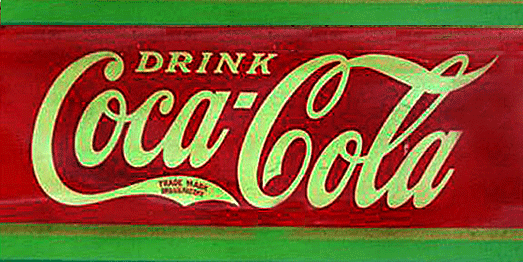
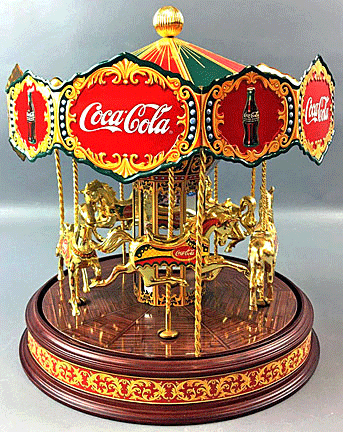 This
change was great for collectors who want to date Coca-Cola items as
being before 1940 but can lead to many problems for dating items made
after 1940. Naturally many novice collectors don’t know the difference
and end up paying way too much for items produced more recently. This
change was great for collectors who want to date Coca-Cola items as
being before 1940 but can lead to many problems for dating items made
after 1940. Naturally many novice collectors don’t know the difference
and end up paying way too much for items produced more recently.
Coke items can be found anywhere at virtually any price point. The low
and middle market for Coca-Cola collecting has been steady but not what
it once was in its heyday. The top end, mint and exceptionally rare,
continues to be strong and growing. With TV programs like American
Pickers and Pawn Stars, the market is solid for Coca-Cola signs.
Original Coca-Cola signs, metal or porcelain, are fetching heavy money
and breaking sales records.
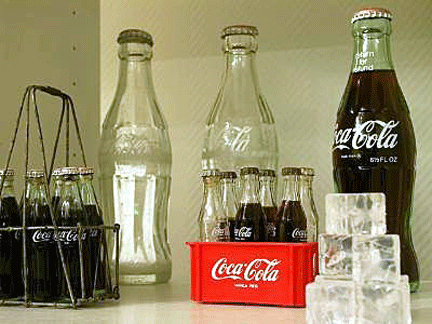 The
market for Coke-related items has always been relatively good because of
the shear number of items produced. Whether it’s a new Super Bowl bottle
or an old calendar. It’s a good idea for beginning collectors to do
research before making an expensive purchase and to consult more than
one source for information. The
market for Coke-related items has always been relatively good because of
the shear number of items produced. Whether it’s a new Super Bowl bottle
or an old calendar. It’s a good idea for beginning collectors to do
research before making an expensive purchase and to consult more than
one source for information.
EBay alone lists over 200,000 collectibles for sale, ranging from
original 6.5-ounce glass bottles for 99 cents each to lifetime
assortments well into six figures. Restored and working vending machines
can cost $10,000 or more. Early porcelain signs and those with original
neon enhancements frequently sell for thousands as well. And because of
the huge variety of merchandise, many collectors tend to specialize by
era, type or size.
Fakes
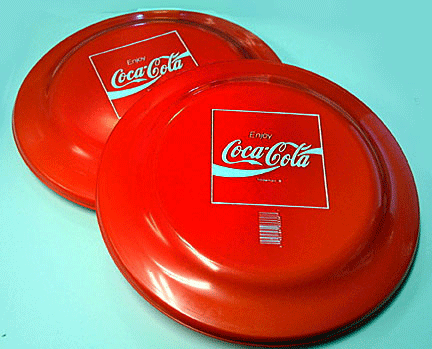 Because
Coca Cola has been around for over 130 years, there’s a huge number of
collectible items on the market. And with the proliferation of online
auction and sales sites, the number has steadily grown. But this means
there’s an even greater chance that some of these items are
reproductions or outright fakes. Because
Coca Cola has been around for over 130 years, there’s a huge number of
collectible items on the market. And with the proliferation of online
auction and sales sites, the number has steadily grown. But this means
there’s an even greater chance that some of these items are
reproductions or outright fakes.
The difference between a reproduction and a fake is that there never was
an original item like the fake. At first, the Coca-Cola Company made it
easy to make their reproductions look like the originals produced 50 to
100 years before. For example, the reproduction trays from 1974 had only
a small written notice on the rim of the trays to say they were recently
made. But savvy sellers could easily remove the notice by scraping it
off with a pocket knife.
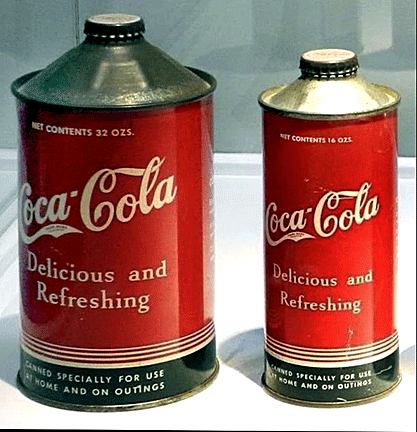 The
overwhelming number of reproductions of Coca-Cola collectibles makes it
imperative that collectors learn as much as possible Coca-Cola items.
Beginners can learn a lot from price guides and online forums. The
overwhelming number of reproductions of Coca-Cola collectibles makes it
imperative that collectors learn as much as possible Coca-Cola items.
Beginners can learn a lot from price guides and online forums.
Reproduction serving trays from the 1930s, for example, have a note on
the back saying so. The original had sharper lithography with a
dark-colored back while the reproduction trays had less-than-sharp
lithography and a light colored back.
< Back
to Collectibles Archives Next
Article >
|
